Top Tier CPU Air Coolers Q3 2015: 9-Way Roundup Review
by E. Fylladitakis on July 6, 2015 8:00 AM ESTThe SilentiumPC Grandis XE1236
SilentiumPC is a Polish company that is fairly well known in Europe, yet with virtually no presence in the North American markets. The company was founded in 2007, aiming to provide a wide variety of cooling and case solutions at competitive prices. For the means of this review, SilentiumPC provided us with the Grandis XE1236, which currently is the best cooler the company produces.
The Grandis is supplied in an aesthetically plain but effective cardboard box. There is nothing of note regarding the appearance of the packaging, as the only artwork is a picture of the cooler itself. It does offer good shipping protection though, with the cooler protected inside a clear plastic shell and the bundled items grouped in secondary cardboard boxes.
With the company focused on minimizing the costs, we did not expect the bundle of the Grandis to be grand. Nevertheless, besides the necessary mounting hardware and wire clips for three fans, SilentiumPC provides a tube of quality Pactum PT-1 thermal compound and a Y 4-pin fan power splitter. A small wrench tool is also provided, necessary for the installation of the cooler.
The Grandis is supplied with two 120 mm cooling fans. Both fans are mechanically and electrically identical, with black solid frames and tinted black blades. They have been rebranded and it is difficult to recognize their OEM. Their electrical specifications, speed and sleeving type match the Power Logic PL12S12L, yet the acoustic ratings are worlds apart.
The Grandis XE1236 is a symmetric dual tower CPU cooler, with relatively narrow towers for its class. The fins of both towers are perfectly symmetric as well, meaning that both their front and rear sides are identical, mostly straight with shallow indentations near their center. SilentiumPC died the top fin black, obviously for aesthetic purposes only, but it does not cover the copper heatpipes.
Up to three 120 mm cooling fans can be installed on the Grandis, using the provided wire clips. The wire clips are strangely shaped and very wide, expanding above and below the cooling fans. This makes them flimsy and prevents the movement of the front fan upwards to offer clearance for the RAM modules, if necessary. The center fan will have to be removed for the installation of the cooler, as there are no holes for a screwdriver. Do note that a Philips PH2 screwdriver with a shank longer than 145 mm is necessary for the installation of the Grandis, which is not supplied.
The base of the Grandis XE1236 is about as simple as the rest of the cooler is. It is split into two parts: the narrow lower copper part serves as the contact surface and the aluminum/steel top part provides mechanical cohesion and retention. Six 6 mm copper heatpipes expand from the base of the cooler to either tower on both sides, evenly spaced at the right and the left half of each tower. In order to keep the costs down, SilentiumPC did not plate the copper parts of the Grandis. The quality of the contact surface is disappointing, not because it has not been polished at all but because there are multiple machining marks visible with the naked eye and easily feelable by touch.


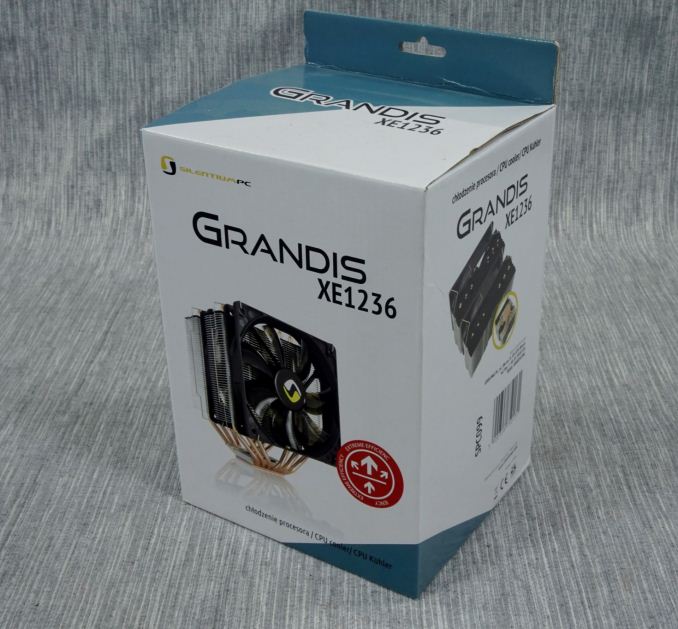
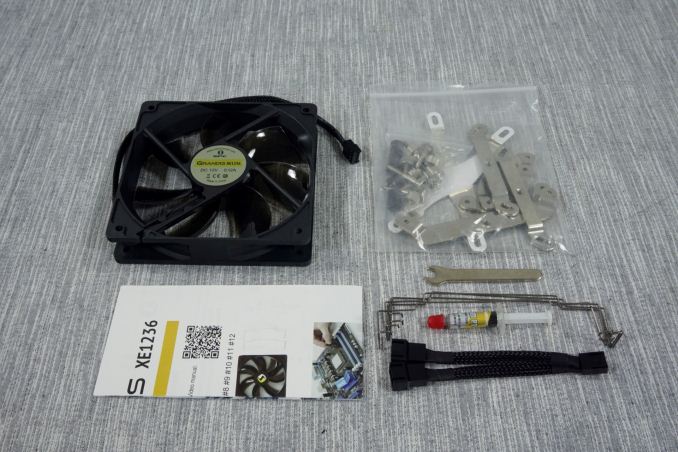
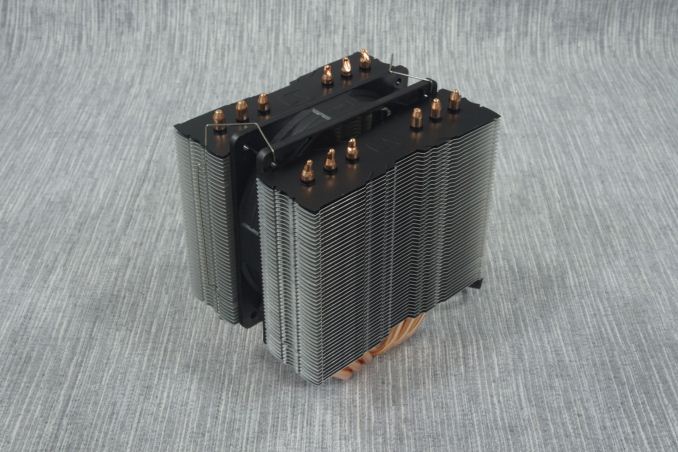
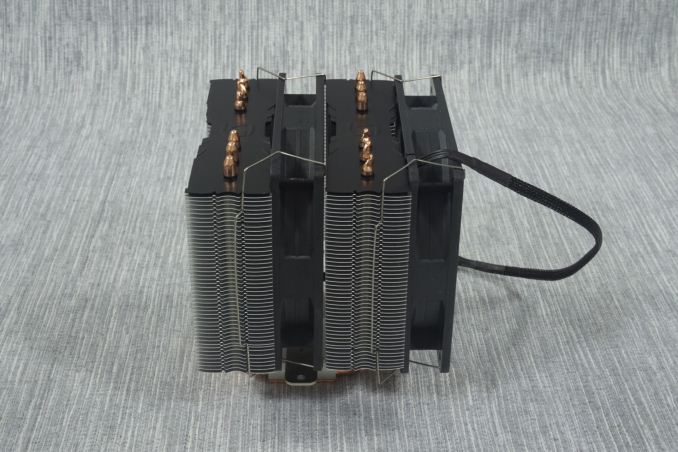
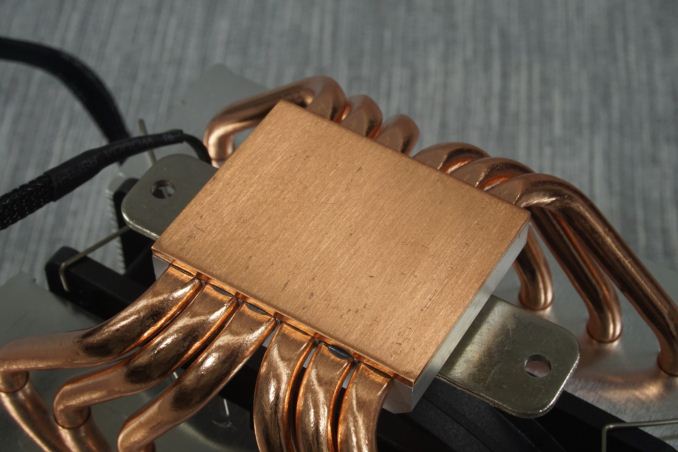








135 Comments
View All Comments
Narcissist - Tuesday, July 14, 2015 - link
I fully agree with the Oxford Guy. I've got a NoFan CR-95C cooling my non-OC i7 4790K. This in conjuction with a couple of M.2 SSD-units, a passively cooled PSU and a passively cooled graphics card makes for a 100% quiet and rather powerful computer. To be on the safe side I've added a Noctua D14 which is configured to force air across all components when the motherboard temperature gets over 50 degC. I is almost never active, though. I've run the Prime95 "Torture Test" for prolonged periods but the CPU-temp consistently stays below 70 degC. In my opinion the NoFan unit is doing a splendid job, although at a price.Sivar - Friday, February 5, 2016 - link
Listen to Oxford Guy. I've used three NoFan models and they all work amazingly well...as long as your CPU's power consumption stays under 100W. If you use a 6- or 8- core i7, or if you overclock enough to hit the 100W envelope, fanless is not for you.Note that NoFan coolers benefit only slightly when a fan is used. They are truly built as fanless coolers from the ground up.
lagittaja - Monday, July 20, 2015 - link
My HTPC has a G2120 with NH-U12P, HD5670 with Accelero S1r2, 64GB Samsung 830 + 1TB WD Black along with 80+ Plat 400W fanless PSU. Inside Lian Li A05N.Only fans being filtered intake Gentle Typhoon @~600rpm and exhaust Slip Stream ~400rpm.
Pretty overkill cooling wise. Could drop the fan speeds even further..
To answer your question, yes it can easily handle it provided there's a teeny weeny bit of airflow in the case.
Work rig has a HR-02 Macho with 800rpm Slip Stream cooling a 3770K@4.7Ghz/1.336V. Could run it fanless if I'd drop the clocks to say 4.3/1.1 or so..
Cvengr - Friday, December 25, 2015 - link
It would simply be the ratio of surface area of the fins to the surface area of the top of the CPU making contact with the heat collector. The fans merely dissipate the heat more quickly over the same area.The advantage of the fans are to transfer the heat by convection to the outer environment more quickly than allowing the heat to build up closer to other components in the system.
If designed for heat transfer, the other components are likely to have been designed assuming an ambient temperature at a particular max level, say 100-130degF. As the delta Temp between the environment and the part generating the heat will increase, so will the heat flow by conduction.
Intent is to draw the heat as far away from the components as possible.
One problem in these designs is to get the heat away from the CPU, as well as the Motherboard components, as well as other components in the case, so the interior case temperatures don't approach the environmental max design temps of those components.
A disadvantage in building by components, is that the component manufacturers are likely to only design for their particular component or one they support.
A common problem in Data Centers is how to remove all the heat from the racks and equipment within them. ANSI/TIA 942 stds go a long way to coordinate between disciplines and trades to effect proper HVAC in the server areas, but even within the racks and cabinets, too many designs limit themselves to providing a temperature set point at different areas in the room, but fail to flow adequate air over the equipment to transfer the heat away from the local electronics environments.
Computer Room Air Conditioners (CRAC) units are notorious for being installed to remove heat, but fail to provide adequate ventilation (air movement) within the computer rooms.
Since most of the CRAC units use split systems (condensate lines in 1/2" copper tubing running through the wall to a condenser outside the building), The natural trend would be to incorporate a small heat exchanger using a CPU water cooling fluid as the secondary, and the chilled water from the condensate of a HVAC system as the primary chilled water to remove the heat.
I haven't shopped the Enterprise level systems. I wonder if such systems are commodities.
sjakti - Monday, July 6, 2015 - link
Interesting article, thank you! I especially appreciate the "Quick Conclusions", that's a great table.Shadow7037932 - Monday, July 6, 2015 - link
I wish you guys had included the Hyper 212+/EVO in the review as the base comparison.zodiacfml - Monday, July 6, 2015 - link
True. It should be the default heatsink to compare with. Now that majority of Intel's CPUs become low power and efficient, these dual tower designs seem overkill except for the unlocked multiplier overclocker or fanless PCs.Achaios - Monday, July 6, 2015 - link
Obsession with CM Hyper 212 EVO "Hypertwohundredtwelvetitis" is a disease also prevalent in Overclock.net. People go berserk over the 212, almost as if they have been mass brainwashed or mass hypnotized. To my best understanding, this mass hysteria is due to the fact that cheap "enthusiasts" may save up to the hugely important sum of $9.99 if they go with the 212 compared to other coolers for the wondrous performance gain of 0.8 Celsius. In other words, the mass hysteria with the 212 is because if you go with the 212, you will save enough money in the end to buy a pack of cigarettes and a can of beer.Nagorak - Monday, July 6, 2015 - link
Well every little bit counts, and to be honest I can understand why people would not want to spend $70-$80 on a heatsink. Getting a decent heatsink for $30-$40 makes sense for a lot of people. However, if you consider wasting money buying cigarettes to be reasonable, I can understand why you wouldn't put much stock in saving a few bucks.Achaios - Monday, July 6, 2015 - link
Given how many overclockers and enthusiasts actually use the CM Hyper Evo 212 in their rigs (as eveidenced at Overclock.net) I think that Zodiacfml's suggestion of the CM hyper Evo 212 being used as a baseline cooler is a good one and I recommend the OP to take it.